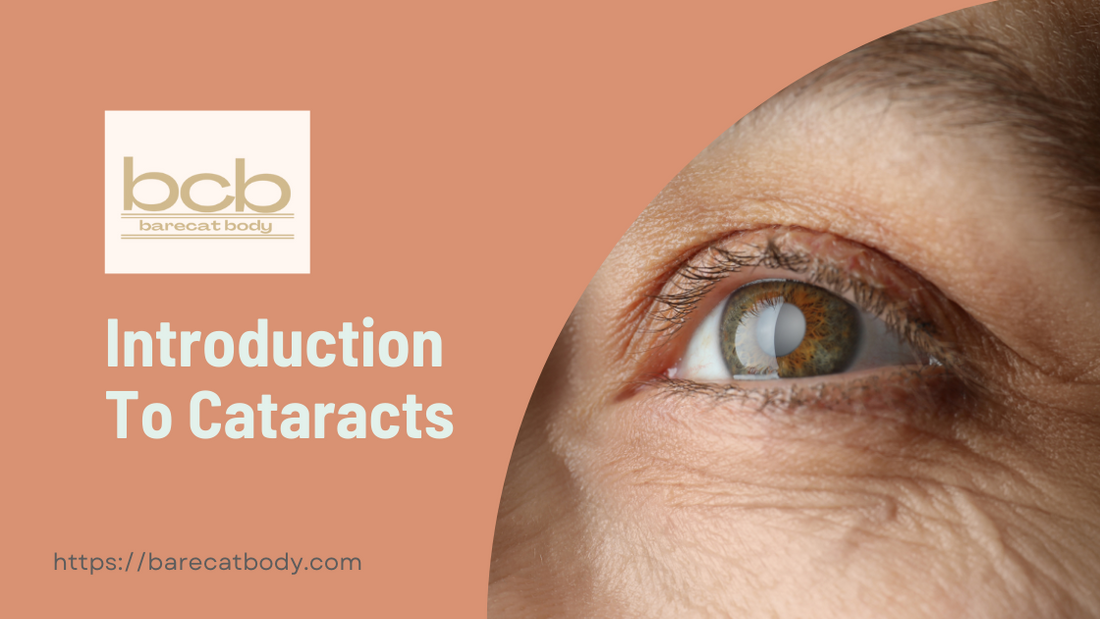
Introduction to Cataracts: Causes, Symptoms, and Treatment
Share
Cataracts are a common eye condition that affects millions of people worldwide, particularly as they age. While cataracts are often associated with older individuals, they can develop at any age. Understanding cataracts, their causes, symptoms, and treatment options is essential for maintaining good eye health and ensuring a high quality of life. Lets take a closer look at cataracts, shedding light on their nature, progression, and management.
What Are Cataracts?
Cataracts are a clouding of the eye's natural lens, which is responsible for focusing light on the retina, enabling us to see clearly. The lens is primarily composed of water and proteins arranged in a precise manner to keep the lens clear and allow light to pass through. As we age, these proteins may clump together, forming cloudy areas that hinder the passage of light.
Imagine the lens of your eye as a clear window that has become frosted or fogged up. This cloudiness can vary in severity, from minor clouding that hardly affects vision to a more pronounced opacity that can result in significant vision impairment.
What Causes Cataracts?
Cataracts can develop for various reasons, and while aging is the most common factor, they can also be caused or accelerated by other factors:
-
Aging: Age-related cataracts are the most prevalent. Over time, the proteins in the lens can break down and clump together, leading to cataracts.
-
Genetics: Some people may have a genetic predisposition to cataracts, making them more likely to develop this condition.
-
Trauma: Eye injuries can lead to the development of cataracts, especially if there is damage to the lens.
-
Medical Conditions: Certain medical conditions, such as diabetes, can increase the risk of cataracts.
-
Medications: Prolonged use of corticosteroids or other medications can contribute to cataract development.
-
Radiation and UV Exposure: Extensive exposure to UV rays or radiation can increase the risk of cataracts.
-
Lifestyle Choices: Smoking and excessive alcohol consumption have been linked to cataracts.
-
Poor Nutrition: A diet lacking in essential vitamins and antioxidants can increase cataract risk.
Common Symptoms of Cataracts
Recognizing the symptoms of cataracts is crucial for early diagnosis and intervention. While cataracts can develop slowly and may not produce noticeable symptoms in their early stages, common signs include:
-
Blurry Vision: The most common and earliest symptom is a gradual decline in vision quality. You may notice that your vision becomes increasingly blurry.
-
Glare Sensitivity: Cataracts can make bright lights, like oncoming headlights when driving at night, appear glaring and more challenging to tolerate.
-
Reduced Color Perception: Some individuals with cataracts may experience a yellowing or browning of their vision, impacting their ability to perceive colors accurately.
-
Double Vision: Cataracts can lead to double vision in one eye.
-
Frequent Prescription Changes: You may find that you need to change your eyeglass prescription more frequently.
-
Difficulty Reading: Reading small print or focusing on close objects can become more challenging.
-
Decreased Night Vision: Night vision may deteriorate, making it more difficult to see in low-light conditions.
Diagnosis and Examination
If you experience any of these symptoms, it's crucial to schedule an eye examination with an ophthalmologist or optometrist. They will perform a series of tests to diagnose cataracts and determine their severity. Some of the common diagnostic tests include:
-
Visual Acuity Test: This eye chart test measures your ability to see at various distances.
-
Slit-Lamp Examination: A special microscope with a bright light is used to examine the eye's structures, including the lens.
-
Dilated Eye Exam: The doctor will use eye drops to dilate your pupils, allowing for a more thorough examination of the retina and lens.
-
Tonometry: This test measures intraocular pressure, which can help rule out glaucoma.
-
Retinal Exam: The doctor may examine the back of the eye to assess the health of the retina.
-
Glasses Prescription Check: Your eyeglass prescription will be evaluated to ensure that vision problems are not simply due to changes in prescription.
Types of Cataracts
Cataracts can be categorized based on their location within the eye and their cause:
-
Nuclear Cataracts: These cataracts form in the center (nucleus) of the lens. They are often associated with aging.
-
Cortical Cataracts: Cortical cataracts develop in the lens cortex, the area surrounding the nucleus. They are characterized by white, wedge-like opacities.
-
Subcapsular Cataracts: These cataracts develop beneath the lens capsule, which is the outer part of the lens. They tend to progress faster and are often associated with diabetes and certain medications.
-
Congenital Cataracts: Some individuals are born with cataracts, known as congenital cataracts. These may be present at birth or develop in early childhood.
-
Traumatic Cataracts: Cataracts can form as a result of eye injuries or trauma.
Treatment Options for Cataracts
Cataracts do not usually require immediate treatment when they are mild and not significantly affecting vision. However, as they progress and start to interfere with daily activities, treatment becomes necessary. The most effective treatment for cataracts is surgical removal.
Cataract Surgery
Cataract surgery, also known as phacoemulsification, is a common and highly successful procedure. During the surgery, the cloudy natural lens is removed and replaced with an artificial intraocular lens (IOL). This IOL can correct vision, reducing or eliminating the need for glasses or contact lenses.
Key points about cataract surgery:
- Outpatient Procedure: Cataract surgery is typically performed on an outpatient basis, and patients can return home the same day.
- Fast Recovery: Recovery is usually quick, with most patients experiencing improved vision within a few days to a week.
- Minimal Discomfort: The procedure is minimally uncomfortable, and patients are usually awake but sedated during the surgery.
- Advanced IOLs: There are various types of IOLs available, including those that correct astigmatism and offer multifocal capabilities.
Lifestyle and Dietary Changes
In the early stages of cataract development or when surgery is not immediately required, certain lifestyle changes can help manage cataracts and potentially slow their progression:
- Healthy Diet: Eating a diet rich in antioxidants and nutrients like vitamin C and E can support eye health.
- UV Protection: Wearing sunglasses that block UV rays can reduce the risk of cataracts.
- Smoking Cessation: Quitting smoking can significantly decrease the risk of cataracts.
Medications
There are currently no medications available that can dissolve cataracts. However, certain medications can help manage the symptoms of cataracts, such as eye drops to reduce glare or discomfort.
The Potential Benefits of Castor Oil in Cataract Management
Castor Oil: An Ancient Remedy
Castor oil, extracted from the seeds of the castor bean plant (Ricinus communis), has a long history of use in traditional medicine and home remedies. It's known for its diverse applications, from skin care to digestive health. One of its reputed uses is in promoting eye health and potentially reducing cataracts.
The Components of Castor Oil
Castor oil is composed of several beneficial components that may contribute to its potential effectiveness in cataract management:
-
Ricinoleic Acid: This is the primary fatty acid in castor oil and is known for its anti-inflammatory properties.
-
Antioxidants: Castor oil contains various antioxidants that help combat oxidative stress, which plays a role in cataract development.
-
Anti-Inflammatory Properties: Inflammation in the eye can exacerbate cataracts, and castor oil's anti-inflammatory properties may help alleviate this.
-
Antibacterial Properties: Castor oil has antibacterial properties that can protect against eye infections, which might be a concern in individuals with cataracts.
-
Rich in Omega-6 Fatty Acids: These essential fatty acids are beneficial for overall eye health.
Potential Benefits of Castor Oil for Cataracts
While there is limited scientific research on the direct effects of castor oil on cataracts, some proponents believe that it may offer the following potential benefits:
-
Anti-Inflammatory Action: Castor oil's anti-inflammatory properties could help reduce inflammation in the eye, potentially slowing the progression of cataracts.
-
Antioxidant Protection: The antioxidants in castor oil may combat oxidative stress, which is known to contribute to cataract development.
-
Lubrication and Moisture: Applying castor oil as eye drops may provide lubrication and moisture to the eyes, helping relieve discomfort associated with cataracts.
-
Protection Against Infections: The antibacterial properties of castor oil can help protect the eyes from infections, which could be a concern in individuals with cataracts.
-
Reduction of Swelling: Some proponents believe that castor oil can help reduce swelling in the eyes, alleviating discomfort.
Using Castor Oil for Cataracts
If you're interested in exploring the potential benefits of castor oil for cataracts, it's important to do so with caution. Here are some general tips on how castor oil may be used for cataract management:
-
Pure and Cold-Pressed Castor Oil: Ensure that you are using pure, cold-pressed castor oil, free from additives or impurities.
-
Eye Drops: Some individuals apply castor oil as eye drops. To do this, dilute the castor oil with a sterile saline solution and use an eyedropper to apply one or two drops to each eye. It's crucial to consult with an eye specialist before attempting this.
-
Topical Application: In some cases, castor oil is applied topically around the eyes to promote overall eye health. Gently massaging the oil into the skin around the eyes may help. The skin's ability to absorb substances varies based on factors such as its thickness, moisture level, and overall health. In general, the thinner and more hydrated the skin, the better it can absorb substances.
-
Consult a Professional: Always consult with an eye care professional before using castor oil for cataracts. They can provide guidance on whether this approach is suitable for your specific condition.
The Need for Scientific Evidence
While the potential benefits of castor oil for cataracts are intriguing, it's important to note that scientific evidence supporting its efficacy is limited. Most eye care professionals recommend cataract surgery as the primary and most effective treatment for cataracts, particularly when the condition significantly impairs vision.
Research on alternative and complementary approaches, including castor oil, is ongoing. To ensure your eye health and receive the most appropriate treatment, it's crucial to consult with an eye specialist who can provide evidence-based guidance tailored to your specific needs.
the quality of life for those affected by this common eye condition.
In Conclusion
Cataracts are a common eye condition that affects people of all ages, although they are more prevalent in older individuals. While they can be a natural part of the aging process, understanding the causes, symptoms, and treatment options for cataracts is crucial for maintaining good eye health. Early diagnosis and regular eye check-ups are key to effectively managing cataracts and preserving your vision. If you suspect you have cataracts or are experiencing vision changes, it's essential to consult with an eye care professional who can provide guidance and recommend appropriate treatments. Whether it's through surgery or lifestyle changes, the goal is to ensure that cataracts do not hinder your ability to see the world clearly and enjoy a high quality of life.
Nurture yourself, Naturally
